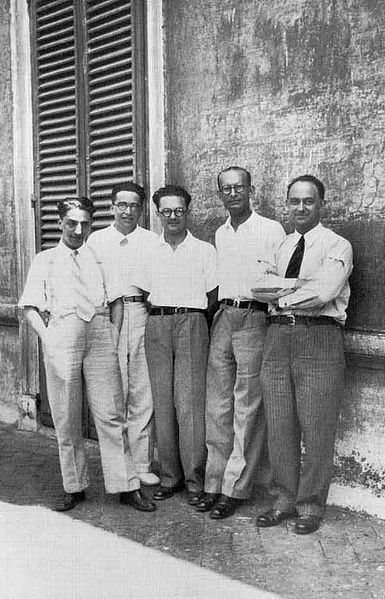Emilio Gino Segrè was an Italian and naturalized-American physicist and Nobel laureate, who discovered the elements technetium and astatine, and the antiproton, a subatomic antiparticle, for which he was awarded the Nobel Prize in Physics in 1959 along with Owen Chamberlain.
Segrè in 1959
The Via Panisperna boys in the courtyard of Rome University's Physics Institute in Via Panisperna. Left to right: Oscar D'Agostino, Segrè, Edoardo Amaldi, Franco Rasetti and Enrico Fermi.
Segrè's ID badge photo from Los Alamos
Technetium is a chemical element; it has symbol Tc and atomic number 43. It is the lightest element whose isotopes are all radioactive. Technetium and promethium are the only radioactive elements whose neighbours in the sense of atomic number are both stable. All available technetium is produced as a synthetic element. Naturally occurring technetium is a spontaneous fission product in uranium ore and thorium ore, or the product of neutron capture in molybdenum ores. This silvery gray, crystalline transition metal lies between manganese and rhenium in group 7 of the periodic table, and its chemical properties are intermediate between those of both adjacent elements. The most common naturally occurring isotope is 99Tc, in traces only.
Technetium
Periodisches System der Elemente (1904–1945, now at the Gdańsk University of Technology): lack of elements: 84 polonium Po (though discovered as early as in 1898 by Maria Sklodowska-Curie), 85 astatine At (1940, in Berkeley), 87 francium Fr (1939, in France), 93 neptunium Np (1940, in Berkeley) and other actinides and lanthanides. Old symbols for: 18 argon Ar (here: A), 43 technetium Tc (Ma, masurium), 54 xenon Xe (X), 86 radon, Rn (Em, emanation)
Chloro-containing coordination complexes of technetium (99Tc) in various oxidation states: Tc(III), Tc(IV), Tc(V), and Tc(VI) represented.
The first technetium-99m generator, unshielded, 1958. A Tc-99m pertechnetate solution is being eluted from Mo-99 molybdate bound to a chromatographic substrate







